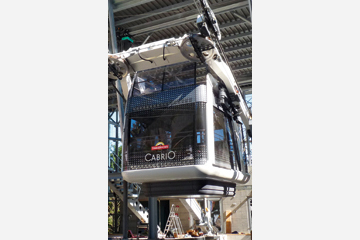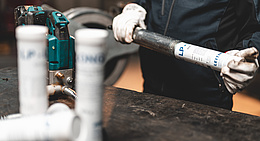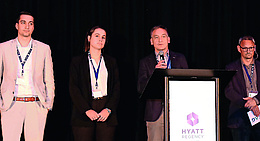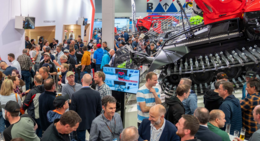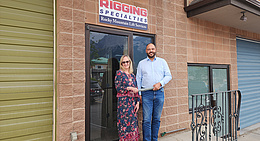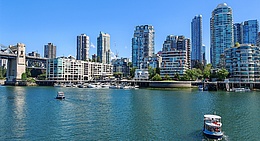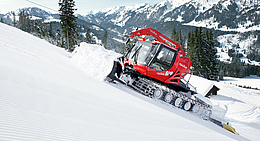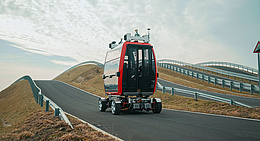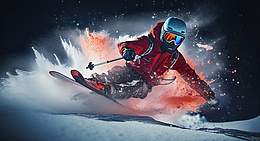Compared with other ropeway construction projects, the design of the cabins played an extremely important role in the sales negotiations and was doubtless the critical factor in the decision to award the contract for the cabins for the Stanserhorn Cabrio-Bahn to the Swiss Gangloff company.
- The double-decker concept with an open top deck called for new solutions with regard to the use of space and passenger movements. The interior of the lower deck is dominated by a central spiral staircase, which was designed to ensure that · the stairs are not too wide so that passengers can hold tight on both sides so as to reduce the risk of accidents,
- the staircase is not too steep for convenient use, and
- the diameter is not so large that there is not enough space on the lower deck for the free movement of wheelchairs.
Underneath the staircase, space was found to accommodate some of the electrical controls, and the cabin attendant’s stand is also at the foot of the staircase.
STRUCTURAL ENGINEERING
The innovative system of a wide-gage reversible ropeway with the carriers traveling between and on a level with the twin track ropes makes completely new demands of the supporting structure for the cabins. The Cabrio-Bahn cars are also fitted with a self-regulating hydraulic system that keeps the floors level regardless of load conditions and external forces. The calculations therefore had to take account of load cases that are not otherwise encountered on a jigback, and that played a significant role in the design of the supporting structure.
Jigback cabins of this size normally incorporate suspension rods to handle the vertical forces. In this case that was not possible because they would have formed an obstacle to passenger movements to the left and right of the staircase. In addition, one of the points at which the cabin is supported by the carriage frame is located immediately above the door to the lower deck. The supporting structure – a completely lightweight alloy design – was accordingly incorporated in the floor frame for the top deck, with two sturdy cross-members connecting the cabin suspension points plus two longitudinal side members. The floor of the top deck rests on a radial assembly of auxiliary members.
The white plastic cladding of the sidewalls conceals members made of welded bent steel plate, which connect the supporting frame with the floor of the lower deck. These members are the equivalent of the suspension rods in a more conventional design.
The lower deck floor frame is more or less a conventional assembly using aluminum extrusions. It also carries the attachment points for the underfloor equipment.
EXTERNAL SKIN
The external skin of the cars is mainly glass. For reasons of weight, it was not possible to employ tinted glass at the level of the intermediate deck. Instead, painted metal panels were used, with GRP elements (glass-reinforced plastic) at front and rear and for the corners. The glazing takes the form of convex and double convex laminated glass panels glued to the supporting structure.
The white cladding for the external frame and floor is also GRP. These parts have a purely aesthetic role without any load-bearing function.
In order to be able to incorporate a sliding door with the required clearance, the external frame had to be divided into two in the area of the door; one part is attached to the door and moves with the door as it opens and closes. This solution was adopted for the design effect with the door closed and for the required clearance with the door open at the same time.
The underfloor systems enclosure is comprised of permanently mounted corner elements with intermediate covers that can be quickly opened or even completely removed for inspections and maintenance. At the center of the enclosure, underneath the spiral staircase, the engineers have located the piston accumulator and gas bottles for the hydraulic system, with the electrical cabinet with the batteries, battery charger and power electronics on the uphill side and the hydraulics for the self-leveling system on the downhill side.
TOP DECK
The top deck is made of impervious steel roof sheeting. It is slightly higher in the middle so that any water on the roof runs away from the spiral staircase and flows into the surrounding gutter. Wooden planking is used for the floor. There is an air gap between the planks and the steel roof as well as spacing between the individual planks. That permits the rain to drain between the planks onto the roof and from there into the gutter. It is also an elegant solution in terms of looks. For design reasons, the steps are also made of wood.
To facilitate shipping, the balustrade round the top deck is detachable. It comprises laminated glass panes glued to a light supporting railing for an optical match with the lower deck.
The staircase is located in a one-meter high cylinder, with one quarter cut away for access. On the top of the cylinder there is a two-piece watertight cover, with a moving panel that slides over the fixed section to open and close the staircase. This solution makes it easy for the cabin attendant to close the staircase in wet conditions. Under the staircase there is a simple control cubicle for out-of-service operations and the loudspeakers for announcements to passengers on the top deck. Video cameras enable the cabin attendant to monitor the situation on the top deck from the control cubicle on the lower deck.
ACCESS CONTROL
The cabin is designed to carry sixty passengers, with a maximum of thirty on the top deck. Carrier loading is via the lower deck. At the bottom of the staircase leading to the top deck is a Bilexa turnstile, which keeps a count of the number of passengers on the top deck, with the number of available places clearly displayed, and locks automatically when the maximum of thirty is reached. Unloading in the stations is from both decks simultaneously. The top deck has an electric sliding door on one side for that purpose.
The cabriolet car is a masterpiece of engineering. Congratulations to all concerned!
